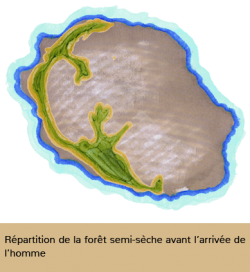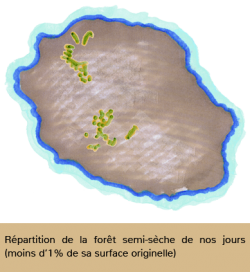Dry Forest
La Réunion is an island which possesses one of the rarest hotspots of biodiversity, thanks to its incredible floristic wealth and its elevated rate of endemism (27%). Indeed, out of the 850 indigenious species recorded on the island, 230 species are strictly and properly endemic of La Réunion. As a matter of fact, the dry forest of La Réunion, a unique ecosystem in the world, is on kthe brink of extinction. Formely present on the entire part of the western side of the island, today it only subsists on less than 1% of its original surface, which represents a few hundred hectares split into a collection of islets known as relics old dry forest. They are barely exceed one hectare and are more or less isolated from each other.
The dry forest main climatic characteristic is the occurrence of a dry period that goes on from April to November. Rainfall is less that 1800 millimeters per year (mm/year) andat times it drops below 500 mm/year/ The average annual temperature ranges from 18° to 24° C. The dry forests are fond of the low slopes of the island and the can be seen from 100 to 600 meters above the see level.
La Montagne range is a broad “natural” massif of a single piece forming a continuos altitudinal gradient between the coastal environments and those of higher altitude. It shelters the main relics of semi-xerophile [Ancient Greek xeros – dry ; philos – like] vegetation on the island at La Grande Chaloupe site (the gorges site found between La Possession and the village of Saint-Bernard).


Additionnally, this specific forest habitat proves to be a strong cultural heritage. This is because the people of La Réunion are accustomed using these plants as herbal tisannery due to their special medicinal properties.




 Français
Français In Progress
In Progress